Final Rule on Work Zone Safety and Mobility Brochure
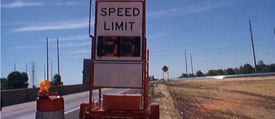
23 CFR 630 Subpart J
A systematic approach to managing work zone safety and mobility
The FHWA recently updated 23 CFR 630 Subpart J, its regulation on work zone safety and mobility. The final rule was published in the Federal Register (69 FR 54562) on September 9, 2004.
Why Update the Rule?
- The original regulation reflected its time. While it addressed procedures and plans to provide for road user and highway worker safety, it did not address the broader impacts of work zones.
- Current issues and trends indicate the following:
- Traffic volumes and congestion are increasing, but there is very little growth in road miles.
- Our highways are approaching middle age, requiring more construction and repair, which means more work zones.
- More work is done under traffic, which increases pressure on contractors to compress schedules, finish projects early, and perform work at night while maintaining safety and the quality of work.
- Work zone safety is a concern, with more than 41,000 injuries and 1,028 fatalities in work zones in 2003.
- Travelers are frustrated with the delays, unexpected road conditions, and inconsistencies caused by work zones.
- The above issues and trends made a strong case for updating the rule to address current issues and better provide for work zone safety and mobility. The changes to the regulation will facilitate comprehensive consideration of the broader safety and mobility impacts of work zones. The updated regulation will also facilitate the implementation of appropriate strategies to help manage these impacts.
- The phrase "broader safety and mobility impacts of work zones" emphasizes that work zone impacts may extend beyond the physical location of the work zone itself. Impacts may be felt on the roadway on which work is being performed, other highway corridors, other modes of transportation, and the transportation network.
Rule Overview
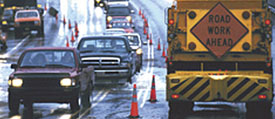
The goals of the new rule are to:
- Expand thinking to address corridor, network, and regional issues while planning and designing road projects.
- Expand work zone impact mitigation beyond traffic safety and control by developing Transportation Management Plans (TMPs) for road projects. A TMP always consists of temporary traffic control strategies, and where necessary, it also consists of transportation operations and public information strategies.
- Advocate innovative thinking in work zone planning, design, and management, so as to consider alternative/innovative design, construction, contracting, and transportation management strategies.
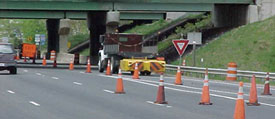
The new rule emphasizes partnership between the FHWA and the states. The rule was written to be flexible to allow states to apply the provisions as appropriate to their respective operating circumstances and to serve the needs of their different project types and classes. It is characterized by a policy-driven focus to institutionalize work zone processes and procedures, with specific provisions for application at the project level.
The rule can be defined by three primary components:
- Policy-level provisions that help states implement an overall work zone safety and mobility policy for the systematic consideration and management of work zone impacts.
- State-level processes and procedures that help states implement and sustain their respective work zone policies.
- Project-level procedures that help states assess and manage the work zone impacts of individual projects.
Policy and Standard Procedures
Implement Overall Work Zone Safety and Mobility Policy
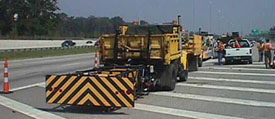
The policy:
- Will facilitate the systematic consideration and management of work zone impacts throughout project development and implementation.
- May be customized as appropriate to individual state's needs.
- May take the form of standard processes and procedures and/or guidance.
- Should be sensitive to varying project characteristics and expected work zone impacts of different project classes.
- Should be developed and implemented through a multi-disciplinary team approach and in partnership with the FHWA.
Implement Standard Processes/Procedures
To help implement its policies, the state should have processes/procedures for:
- Assessing and managing the work zone impacts of projects and/or project classes.
- Requiring training for personnel involved in work zone planning, design, implementation, management, and enforcement.
- Using crash and operational data to monitor performance of ongoing projects and to improve overall processes and procedures.
- Conducting process reviews to assess widescale performance of work zones with the goal of improving work zone processes and procedures.
Applying the Rule to the Project Delivery Process
Systems Planning (TIP/STIP)

Understand the work zone impacts of projects at a conceptual level.
- Identify "significant projects," which are projects expected to cause sustained work zone impacts that are greater than what is considered tolerable based on state policy and/or engineering judgment. This will help allocate resources more effectively to projects early in the project delivery cycle.
Preliminary Engineering & Investigation
Conduct a preliminary identification of the work zone impacts at the individual project level.
- Identify potential work zone impacts of the project.
- Identify potential transportation management strategies.
- Identify other coordination issues (utilities, enforcement, community impacts, etc.).
Design, PS&E, and Contracting
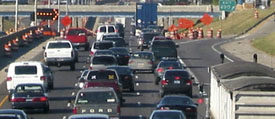
Conduct a more detailed design level assessment of the work zone impacts of individual projects and develop appropriate TMPs.
- Assess work zone impacts of the project through the various design iterations.
- Consider alternative design, construction, contracting, and transportation management strategies in the assessment of work zone impacts.
- Select appropriate transportation management strategies that will help manage the work zone impacts of the project. Develop the TMP based on these strategies.
- Include appropriate TMP items in plans, specifications, and estimates (PS&Es) for the project.
Construction
Implement TMP and monitor and manage work zone impacts during construction.
- Implement TMP strategies.
- Consult with appropriate stakeholders (transit agencies, regional transportation management centers, etc.) in implementing the TMP, to keep them informed and also to seek their input on and knowledge of regional issues.
- Monitor safety and mobility to manage work zone impacts using field observations, crash data, and operational information.
- If necessary, revise the TMP to improve the performance of the work zone.
Performance Assessment
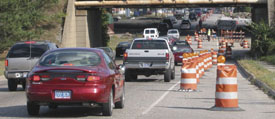
Conduct performance assessment and process review.
- Assess the performance of work zones by analyzing crash and operational data from multiple projects and reviewing randomly selected projects.
- Use the performance assessment results to improve processes and procedures, data and information resources, and training programs for work zones.
For more information on the rule, visit:
www.ops.fhwa.dot.gov/wz/resources/final_rule.htm
U.S. Department of Transportation
Federal Highway Administration
Office of Transportation Operations
Room 3408
400 Seventh Street, SW
Washington, DC 20590
Toll-Free Help Line: 866.367.7487
Telephone: 202.366.1993
Fax: 202.366.3225
Web: www.fhwa.dot.gov/workzones
FHWA-HOP-05-010
